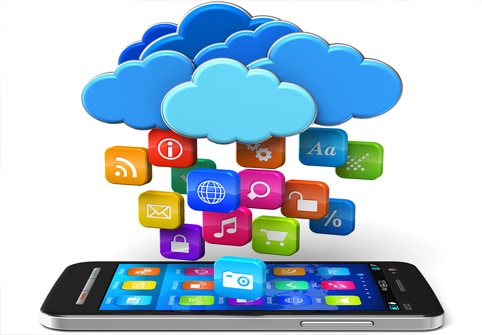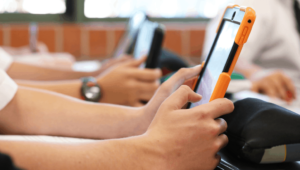Power Management: A New Step in Digital Citizenship

Power management sounds like a way to keep your Who-Moved-My-Cheese principal in check, but this power management deals energy consumption brought about by the one-to-one movement and Bring Your Own Device (BYOD) initiatives that we are seeing in districts across the nation. The cost of energy is a real thing in districts and certainly a real thing in their budgets. Some districts (as many as 300) have cut back to four-day work weeks to save on the cost of fuel for buses and electricity in the classrooms. It appears that the saving are slim, but slim is the budget that many districts are working with.
So what happens when you have 1,200+ new devices in your school that need power? Laptops need power. Smartphones need power. Additional routers, modems, and servers need power. It’s more than nickel-and-diming a school’s budget.
I’ve been able to see a number of 1:1 and BYOD initiatives first hand, and there are some incredible things going on. Internet savvy and innovative teachers are doing some impressive things in their classrooms. (I can’t wait to blog about the teacher who’s using Xbox Kinect in his algebra class.) Yet all of this comes with monetary costs that have budget implications. With the schools that have a BYOD initiative, most students power their devices at home, so in a best-case scenario, they are fully charged at the beginning of the day (depends, though, on how long the car or bus drive was). Once the students arrive at school, this is what typically happens: In the first five classes, everyone is wired, using apps, and interacting in the digital world. In the last two classes at the end of the day, students are back at Old School. No one has any juice left.
Some teachers will roll out long powerstips to let students recharge, but there might be a better way to do it. This is what I call “power management,” which is conserving power and finding alternative sources of energy for mobile devices.
Power management should be a tenant of digital citizenship. Being a good digital citizen is the passport to the modern world, and staying charged and connected is certainly at the base level. An overview of digital citizenship usually looks something like this:
1) Being aware of online hazards, and handling surprise situations.
2) Managing one’s personal information online.
3) Being Internet savvy.
4) Being responsible in online communities.
5) Guarding intellectual property.
Here’s where I would add that sixth tenant or least include it as a caveat somewhere in the first five:
6) Managing mobile power and connectivity.
So all of this new thirst for power doesn’t have to fall completely on the schools. It’s a shared responsibility between the school and student, but it needs to be taught to the students. There are obviously some students and teachers who have figured out a solution before the rest of us even realized it was a problem. To continue, though, let’s divide this into what students should know and what schools can do.
STUDENT POWER
1) Preparation starts at home the night before going to school. Getting your device to a charger should be a bed-time thought, not an early morning wake-up emergency.
2) Manage your power wisely at school. Power down when you’re not using your device. If you’re using a smarthphone that your parents got for you, remember that their primary purpose for it is to be able to contact you, not necessarily to find the sine and cosine in class. So keep some charge for after school.
3) Check your App store for power management apps like Battery Boost Magic that help extend your battery life. Youtube has a number of tutorials, as well, for battery extension tips.
4) Carry additional power with you, which also means carrying all the additional cables with you. Some extended batteries connect right to your phone while others need a cable. Here are a few battery packs to get you started:
- This ultra-cool backpack has a battery inside it. You have to charge the backpack’s battery, at home, but this will help out anywhere that you might need additional power.
- Get an extended battery for your smarthphone or tablet. You have to charge the extended battery, but you can connect it right to your phone while charging and charge both at once.
- The Innergie Pocketcell charges all USB devices.
- The Kensington PowerLift also functions as a phone stand.
- This fashionable purse is stylish and uses interior charging mats.
5) Take control of your own recharging. You can always search for the open outlet, but there are several other alternative green ways to keep your device going.
- This hand-crank charger gives you power in an emergency.
- If you see daylight while you’re at school, these backpacks have solar-powered chargers.
- The Solio Bolt is a small solar-powered battery pack. Perfect if you have a window seat during the day.
6) If your school has a 1:1 initiative where each student has a computer, you can charge your phone right off the laptop if you have the right USB cables for it.
7) Be aware of power management etiquette when you are out in your community. Don’t be power vampires at your local businesses. The coffee shop has to pay for its energy. Buy something from them while you recharge.
SCHOOL POWER
1) If you have students come to your desk to review grades or discuss work, couple that with some recharging time. Be sure to get a green powerstrip that doesn’t bleed energy like the regular power strips. Rearrange your room so that students can use power outlets. Create a workstation that students can rotate into for a recharge.
2) Stay green with other solar powered chargers like Feniz.
3) Using solar panels and buying solar energy are both options.
4) Smaller solar kits are available.
Between solar backpacks and solar kits, solar-powered students may be the wave of the future as devices in school become more common. Additionally, more devices equal more time spent sitting. Why not recharge students’ minds at the same time we’re recharging their devices? Would it be out of the question to have students walk outside for 45 minutes with their backpacks on? The Nokia Bicycle Charger Kit will attach to any bike (including stationary) and charge a phone. Students might exercise with a new-found purpose, especially if the adults share in the recharging fun.
Personally, I must have a BioLite Camp Stove. Not suitable for school, put perfect for camping or home disasters (hopefully minor).
You can spot the people who get this, by the way. Some people have the power management instinct. It’s that girl scrunched over charging her phone at a public power outlet that you’ve walked past a thousand times but never noticed. Or it’s the guy who knows that he can charge his phone off his or a friend’s laptop battery. They are always on the lookout for energy sources and are preparing in advance. One day they will be described like the men and women from the WWII era, the people who could do everything on their own from plumbing the house to fixing the car. Now it will be the kid who could charge the family’s phones by burning sticks in the woods.




0 Comments
Leave a Comment
Your email address will not be published. All fields are required.